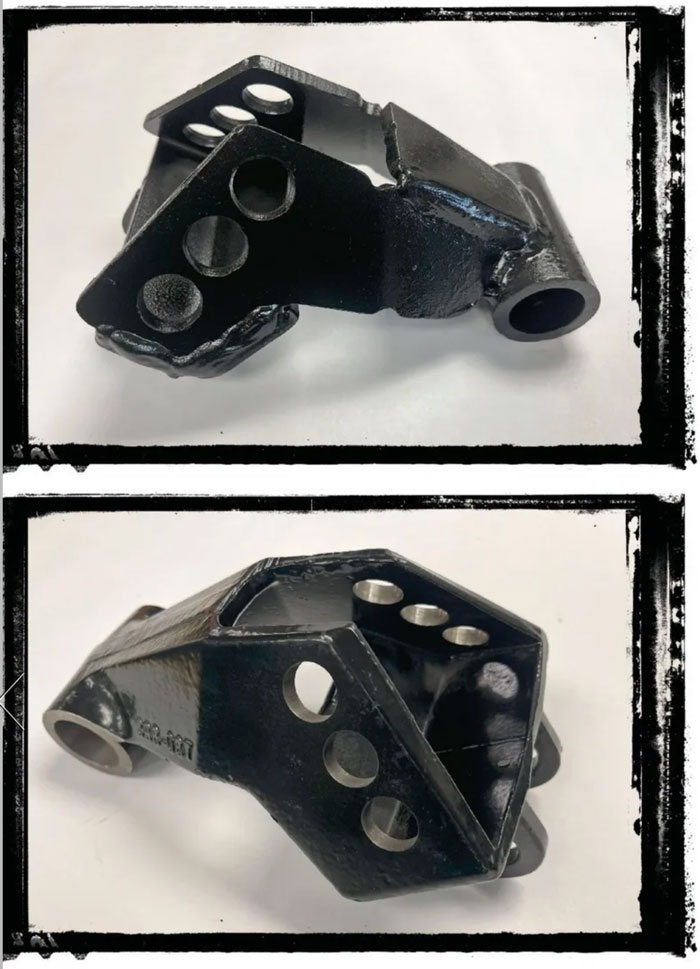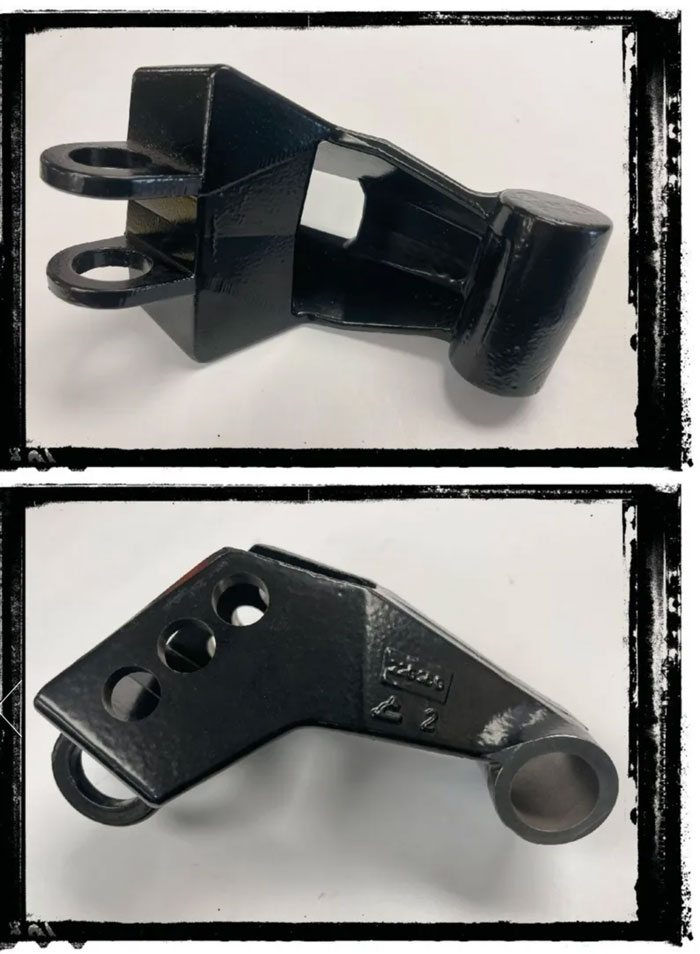This article is reposted with permission from Casting Source.
By Kim Phelan, Editor, Casting Source
Nebraska-based agricultural machinery manufacturer, Orthman, was on a casting-conversion roll starting about six years ago. Along the way, though, a serious problem cropped up in one section of a farming product that was stumping the R&D team. When their foundry partner, AFS Corporate Member Lethbridge Iron Works in Alberta, Canada, planted the seed of an idea, not only was the performance issue solved, but the OEM would realize a 35% cost reduction on the formerly-problematic little part.
The design efficiencies and cost-savings of castings have taken root in the ag manufacturing sector, and farmers seek out the latest developments that help them yield better results in the field. As part of Orthman’s companywide shift from mostly fabricated components to mostly castings throughout their product lines, Orthman had begun focusing attention on its 1tRIPr tillage row unit, a best-seller that breaks up soil compaction to create beneficial seedbed conditions. Towed behind a tractor, the assembly has been made for decades and was undergoing a redesign for a more modern look and functionality.
“The 1tRIPr is made for a great conservation farming practice called strip tilling, where you only till an eight-inch strip of the field rather than turning all the dirt over, said Orthman Engineering Manager Brad Jorgenson. “It saves on erosion; it saves a lot of the soil structures needed for healthy plant growth, and it also allows us to place fertilizer nutrients right next to the plant instead of spreading it all over.
“The focus of this project was to convert most of the machine into castings,” he added. “We’re in central Nebraska and have some of the lowest unemployment levels in the country. So the focus was to reduce our weld labor as much as possible.”
Recently acquired by Unverferth Manufacturing Co., the OEM was working with Lethbridge to convert the weldment parts––except for one.
Engineers intended to keep the row cleaner shoe part intact as a seven-piece weldment, despite having 16 weld segments and being both tedious to fixture and costly in terms of materials, laser cutting, and labor. But a greater problem had surfaced that seemed insurmountable: dimensional inconsistency that caused unreliability in the field.

It doesn’t usually happen, but in this case, the casting looks almost exactly like its weldment predecessor. Casting Source
“I was at their plant in Lexington, Nebraska, discussing field test data,” said Lethbridge Business Development Lead Dylan Bruins. “I went to their R&D lab and spoke with a very frustrated technician who was trying to figure out a way of fixturing [the row cleaner shoe], and it was driving him nuts. The biggest feedback he was getting was a problem with consistency, because no matter how you fixtured this specific part, it was so many pieces that it was just inconsistent by the time they had them fabricated. You would end up with it being slightly deviated in some direction, and it was always a different direction.
“The castings were all lined up exactly the way they wanted them, but this one piece was always inconsistent. He had been tasked with figuring out how to fixture it so it wouldn’t deviate––and he could not figure it out. It was just a nightmare of pieces.”
Bruins took one of the test weldments and the Orthman drawing back to Lethbridge where the foundry team put together a proposed casting that would eliminate all the variables that were causing the weldment’s disparities. The idea quickly took root.
And while a casting doesn’t always resemble the weldment it replaces, remarkably, the Lethbridge ductile iron casting conversion was almost a twin of the fabricated part.
“By the time we did all the back and forth and accommodated the constraints they had as well as our own, the part ended up being the same, and most importantly, it became consistent,” said Bruins. “And that was what they were hoping for.
“They had been putting way too much labor and welding time into a nightmare fabrication––and they were also having the laser cutting done by a third party. So, it was an expensive part, and after bringing all the pieces together, it still didn’t do the job they wanted it to do. I don’t think this would have ever been made into a casting if it hadn’t been for that inconsistency––that was the driving force.”
Better By Design
The cast row cleaner shoe––which was recognized in the AFS/Casting Source magazine annual contest as the 2024 Casting Conversion of the year— is an ongoing production part today, and Lethbridge produces about 3,000 per year. Poured with ductile iron grade 65-45-12, which keeps the part from fracturing while banging against rocks and solid mud, it weighs 7.25 lbs. as a raw casting; 6 lbs. after machining. A single core dropped into the mold creates all the internal geometries of the casting and the holes through the tab section.
Three years after production first began, the cast row cleaner shoe has had zero field failures. As a part that’s dragged through dry mud and bouncing into rocks and other obstacles, that’s saying something.
“It’s such a neat, straightforward casting, and it’s never come up in a quality meeting, said Lethbridge Casting Development Specialist Brandon Derksen. It’s a very simple casting in terms of our process––it’s easy to pour, and it has consistent wall thickness. It’s just a great casting and it’s worked perfectly since Day 1.

As a raw casting, the 1tRIPr row cleaner shoe weighs 7.25 lbs––6 lbs after machining. Casting Source
Lethbridge provides several value-add services for the part.
“After we cast it, we grind it, then it’s powder coated, then it’s machined,” Bruins explained. “As it comes off the machining cell [where six adjustment holes are made] the machining operator presses the bushings into the main bore while the next part is being machined––this saves the customer money on additional pre-assembly labor.”
Because the pin tab features were not dimensionally critical, it was left as an as-cast feature that created a natural hanging point for the powder coat line, he added.
Automation is a major factor in the foundry’s operations from start to finish.
- Cores are made using a Laempe Reich core-making cell.
- Cores are then palletized by a robotic automated storage retrieval system that brings them down to the molding line. (a Hunter-10 match plate automated molding machine).
- Castings are run through an automated blasting system.
- Then they travel into another automated palletizing system to store them.
- Castings are brought to a robotic grinding cell.
- Once ground, they head back into the palletizing system and brought through a final blast cycle.
“We have as little manual handling of the parts as possible and use robotics as much as we can,” said Bruins. “We’re in Alberta, which is often considered the Texas of the North. Historically, when oil prices have been high, guys can drop out of high school and make six figures as laborers in the oil sands up north, which is near impossible for us to compete with.”
Apart from providing substantial cost savings over the fabrication and removing dimensional variance, Lethbridge offered still more advantages, which include having the part number and date of manufacture cast into the part, as well as the OEM having just a single part number to maintain in inventory versus seven. Additionally, finite element analysis showed the part’s yield strength more than doubled as a casting.
Keeping It Simple
Knowing the extent to which a metal casting can utterly transform a welded part, the foundry naturally proposed several ways they could bring on the cool factor––but it turned out, cool on this tool didn’t enhance function.
“When we initially looked at this part, we tried to dress it up,” Bruins said. The limitations of a fabrication were clear in the original design, so we tried to think outside the box. The concept we put together was dramatically different––we thought, ‘Here’s what would be a really cool version of this part. But the way we had designed it didn’t work from a farming perspective, because it would have allowed mud and junk from the field to get in and build up in the row.
“Eventually, we all came to the conclusion that the best way of making that part was the way they were already making it. Simplicity was the answer with this one. Rather than reinventing the wheel, it was a “just make the wheel work better” situation. Our thoughts on how to redesign this part ended up being irrelevant, because there was no need to make it fancy. No one was ever going to see it––it’s the lowest piece of equipment on the ground, and it’s covered by the wheels that are attached to it. This was strictly a functionality project.”
Why Us?
Orthman and Lethbridge Iron Works have been doing business together since 2019, and in that time trust and even friendship have laid a foundation for strong communication and collaboration.
“This is our biggest foray into castings and they’ve been great to work with,” said Jorgenson. “There are certain levels of variability you have with a casting that you don’t have in tubing and sheet metal. They’ve helped us understand both design and process issues. For instance, we might need to tweak some tolerances when we were getting a little less shrinkage than we expected. We’ve also tweaked some hole sizes over the last couple years. Whatever it may be, they find a good solution for it.
“Some of these castings are pretty complex and you can draw up what you want on the screen, but if the mold can’t come apart that way it doesn’t do any good. So, they work a lot with us on getting the drafts right and where the parting lines can be, and making sure we can get good mold flow. We’re in this together.”
Lethbridge Iron Works not only had established a great bond with Orthman, they also had a 15-year history with the new owner, Unverfeth, so the transition has been smooth. Bruins emphasized that to get good casting contracts you have to be ready to give a lot first.
“I believe the reason we got the entirety of the 1tRIPr project is because of our relationship,” said Bruins. “It’s also because of what we offered in the initial stages. There are a lot of foundries that send you a quote when you give them your design, and then you can decide if you want to buy from them or not. We offer customers the preliminary service of walking through your operation and pointing out things that would make more sense as a casting. We work with your design engineers right from the start.
“When we first started working with Orthman, they had never really worked with castings at all and didn’t really know how to go about designing them. We’ve provided education and advice based on what we’ve seen other customers encounter. We earned Orthman’s trust and their jobs because we were willing to put in the hours of helping them on the front end. The worst thing, from the foundry perspective, is an engineer who designs a part that doesn’t work for our equipment and process and isn’t open to feedback. Orthman has always been fantastic. It’s a proper collaboration.”





